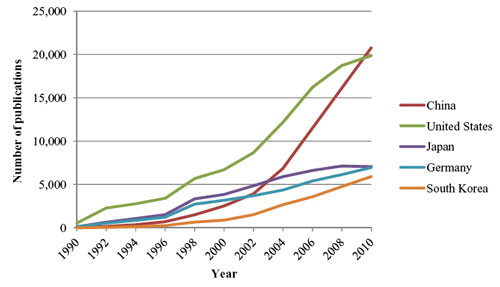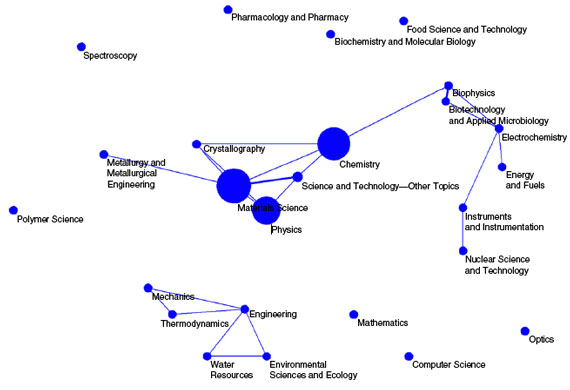| Posted: Dec 05, 2012 | |
Assessing the early impacts of nanotechnology in China |
|
| (Nanowerk Spotlight) A recent review ("Engineering Small Worlds in a Big Society: Assessing the Early Impacts of Nanotechnology in China") analyzes the early impacts of nanotechnology on China’s economic and innovation development in six key areas. It concludes that the country’s effort to join the world leaders in nanoscale R&D has made significant progress. Although several effects are difficult to capture, cross-country and cross-regional collaborations, institutional development, regional spread, industrial and enterprise development, as well as research and education capabilities, have been influenced positively by the new programs in China’s nanotechnology initiative. | |
| However, it seems difficult to estimate the role of particular policies in this process; in other words, what is the specific contribution of nanotechnology programs relative to the entire complex of new initiatives aimed at promoting indigenous innovation in China. The authors – Evgeny A. Klochikhin and Philip Shapira from the Manchester Institute for Innovation Research – find that nanotechnology policies are contributing to addressing existing innovation systems lock-ins and historical path dependencies in China. | |
| In spite of that, many challenges remain, including those of separation of research and training, uneven distribution of science and technology across regions, poor mechanisms of technology transfer, and challenges for independent science-driven entrepreneurial development. | |
| The six key areas, where the authors aim to assess the early impacts of nanotechnology for the Chinese economy and society, are: institutional development, knowledge flows, and network efficiency; research and education capabilities; industrial and enterprise growth; regional spread; cluster and network development; and product innovation. They caution, though, that these areas do not cover the entire spectrum of the social and economic effects of a given technology on individual nations but can be used as a model for an initial estimate of such effects. | |
| Institutional development, knowledge flows, and network efficiency | |
| The establishment of new institutions and improvement of existing mechanisms for interactive learning and competence building, two major elements of a national innovation system. Examples are the U.S. national Nanotechnology Initiative or Russia's RUSNANO. Equivalents in China are the National Center for Nano Science and Technology, Nanopolis Suzhou, and National Natural Science Foundation of China (NSFC). here, the researchers we try to see whether these new institutional arrangements create a better environment for nanoscale R&D and promote commercialization of nanotechnology: "These developments are expected to be evidenced by increasing knowledge flows and growth of collaboration networks in nanotechnology activities over time: increasing coauthorship and copatenting links, new network organizations, and business alliances." | |
| Since 2001, China has created a number of new institutions and dedicated programs at the national and regional levels. In 2004, the National Center for Nanoscience and Technology (NCNST) was cofounded by the CAS, Tsinghua University, and Peking University. It has become an important center of excellence and a hub for frontier knowledge in nanoscale research. The Tsinghua-Foxconn Nanotechnology Research Center was established in Beijing in 2004 and represents an example of successful university–industry collaboration. | |
| The authors find that the nanoscience support programs of the NSFC have had especially vivid influence on the country’s nanotechnology-related publication output. "Two major programs have been introduced: the Nanoscience Basic Research in 2002 with a total funding of RMB 75 million and Nanotechnology Manufacturing in 2008 with a total funding of RMB 150 million. As a result, the number of publications with NSFC funding has increased dramatically in recent years from just over 3,100 papers in 2008 to 15,558 in 2011, which is an increase from 17.5 to 54.2 percent of all nanotechnology publications in China in just three years." | |
 |
|
| Nanotechnology Publications by Five Top Producing Countries, 1990–2010 (Source: Arora et al. Capturing new developments in nanotechnology scientific output: A search strategy for publication records. STIP White Paper. Atlanta, GA: Georgia Institute of Technology). | |
| Research and education capabilities | |
| Given that nanoscale R&D is a multidisciplinary field, many projects in this emerging science and technology area stretch across multiple disciplines and technologies, creating new links and complementarities that may lead to new ideas in research and education. Improved research and education capabilities are expected to be evidenced by the diversity of cross-disciplinary collaborations between scientists and also a number of new specialized education programs that would have various physical, chemical, and/or biological components in them to train specialists of new kind. | |
| The study's analysis of cross-disciplinary links by subject categories in the Thomson Reuters Web of Science shows that nanotechnology scientists in China are spread across a variety of scientific domains and actively collaborate, which may be a sign of increasing complementarities. Materials science, chemistry, and physics represent the largest hubs for nanotechnology research, while other fields are adjacent and include crystallography, metallurgy, biophysics, biotechnology, and others. Engineering sciences represent another large cluster. | |
 |
|
| Cross-Disciplinary Collaborations in Nanotechnology Publications in China, 1996–2011. | |
| Industrial and enterprise growth | |
| Growth in this area implies an increasing number of nanotechnology companies and patenting activity through business alliances and university-industry links. Another parameter, albeit mor difficult to gauge, is the growth of employment associated with nanotechnology. | |
| Previous studies have found that poor mechanisms of technology transfer remain one of the major challenges for the Chinese government. University–industry links are rapidly increasing but remain imperfect with the primary reasons including lack of communication channels and divergence of interests between academic institutions and industry, with the latter having little interest in acquiring frontier knowledge and willingness to transfer mostly mature technologies | |
| To resolve these issues, the Chinese government has employed nanotechnology as one of the possible routes to bringing basic research closer to the market. Several institutions were established to promote commercialization including the Tianjin Nanotech Industrialization Base (2000), Nanopolis Suzhou (2010), and NERCN (2003). | |
| The authors' patent analysis shows that research institutes (including universities, colleges, and CAS institutes) and industry still rarely coinvent (based on the analysis of patent assignees of State Intellectual Property Office [SIPO] patents). Although there has been some growth of this indicator over the last decade, only 4.27 percent of all patents by companies and research institutes were coinvented in 2011. | |
| Regional spread | |
| In China, three major areas have been traditionally most developed technologically and economically – Pearl River Delta near Hong Kong, Yangtze River Delta with the center in Shanghai, and Bo Hai Rim around Beijing and Tianjin. Most regions of China have at least some nanotechnology R&D. "Therefore, the question is if other, less developed provinces in the north and the west of the country use nanoscale R&D to boost their regional economies and innovation growth." | |
| New industrial and science clusters and formal networks | |
| This aspect is linked to the regional spread. The colocation of major research centers and companies may lead to the formation of new synergies and rapid growth of these territories especially if the local authorities provide needed support as evidenced on multiple occasions both in developing and developed countries. | |
| Several regions have emerged most rapidly in the recent decade and tend to form the new clusters around nanotechnology activities: Jilin, Anhui, Hubei, Hunan, Sha’anxi, Sichuan, and Heilongjiang. These provinces outside the three major economic zones have become important locations for nanoscale R&D with 18–41 percent average growth of nanotechnology publication output per year. | |
| Product innovation | |
| This sixth aspect probably is the most difficult one to capture for the study and the authors relied on occasional references to new nanotechnology products in press and academic literature as well as sectoral market research, which seems challenging in many developing countries due to the lack of infrastructure and credible data. | |
| The astudy concludes that the available evidence is not able to say much as to whether China’s invention and production of nanotechnology goods will be transformative for its economic, social, and innovation development. As these products come to market, there may be important economic benefits and spillovers, but there is no clear confirmation yet concerning the distribution of these benefits. | |
 By
Michael
Berger
– Michael is author of three books by the Royal Society of Chemistry:
Nano-Society: Pushing the Boundaries of Technology,
Nanotechnology: The Future is Tiny, and
Nanoengineering: The Skills and Tools Making Technology Invisible
Copyright ©
Nanowerk LLC
By
Michael
Berger
– Michael is author of three books by the Royal Society of Chemistry:
Nano-Society: Pushing the Boundaries of Technology,
Nanotechnology: The Future is Tiny, and
Nanoengineering: The Skills and Tools Making Technology Invisible
Copyright ©
Nanowerk LLC
|
|
|
Become a Spotlight guest author! Join our large and growing group of guest contributors. Have you just published a scientific paper or have other exciting developments to share with the nanotechnology community? Here is how to publish on nanowerk.com. |
|
